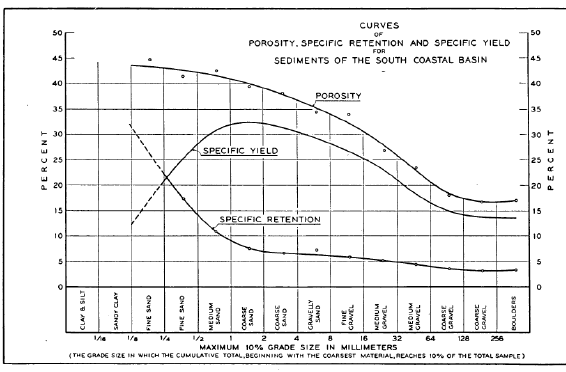
Physics of Unsaturated Zone Flow
The Unsaturated Zone (UZ) is generally considered the area between the land surface and the groundwater water table. The UZ is characterized by cyclic fluctuations in soil moisture as water is replenished by rainfall and removed by evapotranspiration and percolates to the groundwater table as recharge.
The flow of water in the UZ depends on the interplay between three processes:
· Infiltration from the land surface into the soil,
· Evapotranspiration (ET) from the root zone, and
· Flow in the soil pores and deep percolation to the groundwater table.
The entire amount of rainfall will infiltrate into the soil surface if the rate of rainfall is less than the maximum infiltration rate. Generally, the maximum rate of infiltration is when the soil is saturated.
The UZ is coincident with the root zone, which is normally always above the water table. Most plants can tolerate short periods of fully saturated conditions in their roots, but if the roots are saturated for longer periods the roots will typically die off. Thus, nearly all plant ET occurs in the UZ.
The only extraction of water in the unsaturated zone is ET, the water content in the soil below the root zone is in equilibrium with the rate of drainage. Thus, any infiltration that exceeds the capacity of the roots to extract it, will percolate past the root zone and eventually become groundwater recharge.
The UZ is generally differentiated from the Saturated Zone by the presence of air in the soil pores. Thus, the key characteristic of the UZ is the amount of water in the soil pores, or the water content. From this we can define several characteristic water contents:
· Saturated water content, qs, is equal to the porosity. This is the maximum amount of water that can be present in the soil.
· Field capacity, qfc, is amount of water in the soil after it has freely drained and when there is no evapotranspiration. Essentially, the water content is in equilibrium. It is an equilibrium between gravity drainage and the ability of the soil to hold on to moisture.
· Wilting point, qwp, is the minimum water content below which plants can no longer extract water from the soil using osmotic pressure. This is defined as a soil suction of -1500 KPa (-15 bar, pF 4.18).
· Residual water content, qr, is the effective minimum water content for a ‘dry’ soil.
Interestingly, Field Capacity is the language of the agronomist or soil scientist, where it is the related to the plant available water. However, the related Specific Yield is a groundwater term. As defined by a hydrogeologist, Specify Yield is the amount of water that can be abstracted from an unconfined groundwater aquifer as the water table declines due to pumping. In other words, the specific yield is the saturated water content minus the field capacity. This has been recognized for nearly 100 years evidenced by Figure 29.1, which is from a 1963 USGS report, which itself references the figure from a publication from 1934.

Figure 29.1 Relation between Specific Yield, Porosity and Field Capacity (from USGS OFR 63-59, Figure 3)
Note: in MIKE SHE the Specific Yield of the uppermost SZ layer is set equal to qs - qfc.at the beginning of the simulation. However, this is only done at the begin